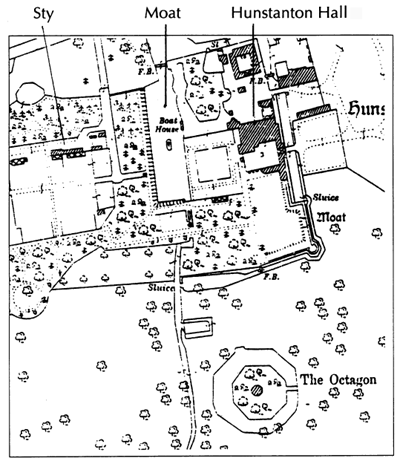The Primal Piggery
Norman Murphy’s convention talk in Houston last October [1999] described how he had tracked down what was probably the inspiration for the Empress of Blandings’ sty at Hunstanton Hall in Norfolk. In his talk, Norman told how he visited and photographed the remains of the sty, and even obtained a photograph of a certain black pig which lived in that sty in the 1920s and which had quite possibly served as the model of the Empress. Not long after his talk, Norman was able to locate for us a map of the Hunstanton Hall area, drawn in 1928, which shows not only the hall and the moat surrounding it, but the pigsty itself.

A portion of the map is shown here, with the hall, moat, and sty labeled. (In some accounts the widened part of the moat is called a lake.) As Norman points out in his In Search of Blandings, PGW spent considerable time at Hunstanton Hall over several years, was probably more familiar with it than with any other country house, and used it and parts of its grounds in several stories, among them Money for Nothing, “Jeeves and the Impending Doom,” and “Mr. Potter Takes a Rest Cure.”
In the lower part of the map you will find a most significant building labeled “The Octagon.” It is a small building on an island only half an acre in extent. It is surely—the hardiest sceptic cannot doubt this—the original of the Octagon where Bertie and the Right Hon. A. B. Filmer took refuge from the furious swan in “Jeeves and the Impending Doom.” In that story Bertie describes the building as having been built “to enable the grandfather of the late owner to have some quiet place out of the earshot of the house where he could practice the fiddle.” Norman’s In Search of Blandings quotes from the memoir of a Hunstanton neighbor to the effect that the Octagon was built about 1600 by a Sir Harmon LeStrange who “was a great music-lover and so fond of the violin that his wife . . . insisted on him building a little house on an island called the Octagon where he could practice to his heart’s content and not disturb those inside the hall.” The parallels between fact and fiction are perhaps closer here than in any other Wodehouse story.
The Octagon had survived more than 300 years when Wodehouse knew it, it was some 25 feet across, and its height I estimate to be at least that great (the swan had an almost unlimited supply of neck), so it was no trifling shed.
In describing his frantic efforts to escape from the angry swan, Bertie says that the "walls [of the Octagon] had grooves at regular intervals which were just right for the hands and feet, and it wasn’t long before I was parked up on the roof . . .” It sounds like a masonry structure, and Bertie’s feat in scaling such a wall without the aid of his usual waterpipe boggles the imagination.
So here is the original of the piggery of immortal fame, and the original of the tower which, though possibly stubby, is at least as legendary as Childe Roland’s. We see them as a bird would have seen them in 1928, and we see them because Norman Murphy provided the map. Who else would have known where to find a detailed map of the Hunstanton area in that crucial period of the 1920s when Wodehouse visited and found inspiration for these stories? Norman is, as many people have noted, a unique phenomenon, but I think Jan Kaufman provided the ideal description of him at a recent meeting of our Blandings Castle Chapter when she said, “Norman Murphy is an Act of God.” Amen.
—Ed Ratcliffe in Plum Lines, Summer 2000.
 Madame Eulalie’s Rare Plums
Madame Eulalie’s Rare Plums